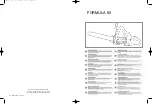
5
■
Safety helmet
–
should comply with EN 397 and be CE marked
■
Hearing protection
–
should comply with EN 352-1 and be CE marked
■
Eye and face protection
–
should be CE marked and comply with EN 166 (for
safety glasses) or EN 1731 (for mesh visors)
■
Gloves
–
should comply with EN381-7 and be CE marked
■
Leg protection (chaps)
–
should comply with EN381-5, be CE marked and
provide all-round protection
■
Chainsaw safety boots
–
should comply with EN ISO 20345:2004 and be
marked with a shield depicting a chainsaw to show
compliance with EN 381-3. (Occasional users
may use steel toe-cap safety boots with protective
gaiters, which conform to EN 381-9 if the ground is
even and there is little risk of tripping or catching on
undergrowth)
■
Chainsaw jackets for upper body protection
–
should comply with EN 381-11 and be CE marked
ADDITIONAL BATTERY SAFETY WARNINGS
■
To reduce the risk of fire, personal injury, and product
damage due to short circuit, never immerse the tool,
battery pack, or charger in fluid or allow fluid to flow
inside them. Corrosive or conductive fluids, such as
seawater, certain industrial chemicals, and bleach or
bleach-containing products, etc., can cause a short
circuit.
■
Charge the battery pack in a location where the ambient
temperature is between 10°C and 38°C.
■
Store the battery pack in a location where the ambient
temperature is between 0°C and 20°C.
INSTRUCTIONS CONCERNING THE PROPER
TECHNIQUES FOR BASIC FELLING, LIMBING,
AND CROSS-CUTTING
UNDERSTANDING THE FORCES WITHIN THE WOOD
When you understand the directional pressures and
stresses inside the wood, you can reduce the pinches or at
least expect them during your cutting. Tension in the wood
means the fibres are being pulled apart, and if you cut in this
area, the kerf or cut tends to open as the saw goes through.
If a log is being supported on a saw-horse and the end is
hanging unsupported over the end, tension is created on
the upper surface due to the weight of the overhanging log
stretching the fibres. Likewise, the underside of the log is
compressed and the fibres are being pushed together. If a
cut is made in this area, the kerf tends to close up during
the cut. This cut would pinch the blade.
PUSH AND PULL
The reaction force is always opposite to the direction the
chain is moving. The operator must be ready to control the
tendency for the product to pull away and push backwards.
The product pulls away (forward motion) when cutting on
the bottom edge of the bar. The product pushes backwards
(towards the operator) when cutting along the top edge.
SAW JAMMED IN THE CUT
Turn off the product, and remove the battery pack. Do not
try to force the chain and bar out of the cut as this is likely
to break the chain, which may swing back and strike the
operator. This situation normally occurs because the wood
is incorrectly supported, which forces the cut to close under
compression, thereby pinching the blade. If adjusting the
support does not release the bar and chain, use wooden
wedges or a lever to open the cut and release the saw.
Never try to start the chainsaw when the guide bar is
already in a cut or kerf.
SKATING/BOUNCING
When the chainsaw fails to dig in during a cut, the guide
bar can begin hopping or dangerously skidding along the
surface of the log or branch, possibly resulting in the loss
of control of the chainsaw. To prevent or reduce skating or
bouncing, always use the saw with both hands. Make sure
that the saw chain establishes a groove for cutting.
Never cut small, flexible branches or brushes with your
chainsaw. Their size and flexibility can easily cause the
saw to bounce towards you or bind up with enough force
to cause a kickback. The best tool for that kind of work is
a hand saw, an axe, pruning shears, or other hand tools.
FELLING A TREE
When bucking and felling operations are being performed
by two or more persons at the same time, the felling
operations should be separated from the bucking operation
by a distance of at least twice the height of the tree being
felled. Trees should not be felled in a manner that would
endanger any person, strike any utility line, or cause any
property damage. If the tree does make contact with any
utility line, the company should be notified immediately.
The chainsaw operator should keep on the uphill side of
the terrain as the tree is likely to roll or slide downhill after
it is felled.
An escape path should be planned and cleared as
necessary before cuts are started. The escape path should
extend back and diagonally to the rear of the expected line
of fall.
Before felling starts, consider the natural lean of the tree,
the location of larger branches, and the wind direction to
judge which way the tree will fall.
Remove dirt, stones, loose bark, nails, staples, and wire
from the tree.
Summary of Contents for RCS36HP
Page 1: ...RCS36HP ORIGINAL INSTRUCTIONS Cordless Chainsaw...
Page 10: ...x 1 x 1 x 1 RCS36HP 10 WHAT S IN THE BOX...
Page 14: ...14...






































